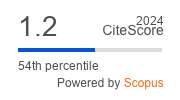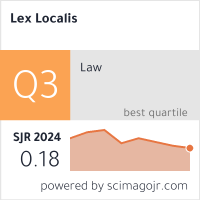Vzorci med-nivojskih razlik med spoloma pri deskriptivni reprezentaciji žensk
DOI:
https://doi.org/10.4335/17.1.53-70(2019)Ključne besede:
lokalne volitve, ženske v politiki, razlike med spoloma, reprezentacijaPovzetek
Pogosto se domneva, da je deskriptivna reprezentacija žensk višja na lokalni ravni kot na državni ali zvezni ravni. Vendar pa nedavne študije ta vzorec izpodbijajo. Zato se sistematično uvaja več alternativnih vzorcev med-nivojskih razlik med spoloma pri zastopanosti ženske preko različnih političnih nivojev. Osredotočili smo se na razlike med spoloma med državno in lokalno ravnijo in postavili hipoteze z več razlagami, zakaj pride do takšnega prepada. Uporabili smo primer ZDA, ki pokaže, kako ženskam včasih relativno bolje uspeva na državnih kot na lokalnih volitvah.
Literatura
Adams, B. E. & Schreiber, R. (2011) Gender, Campaign Finance, and Electoral Success in Municipal Elections, Journal of Urban Affairs, 33(1), pp. 83–97.
Bullock, C. S. & MacManus, S. A. (1991) Municipal Electoral Structure and the Election of Councilwomen, Journal of Politics, 53 (1), pp. 75–89.
Carroll, S. J. & Sanbonmatsu, K. (2013) More Women Can Run – Gender and Pathways to the State Legislatures (New York: Oxford University Press).
CAWP (2017) Women Officeholders 2017 (New Brunswick: Center for American Women and Politics, Eagleton Institute of Politics, Rutgers University), available at: http://www.cawp.rutgers.edu/current-numbers (May 4, 2017).
Center for Women in Politics and Public Policy (2012) Fact Sheet: Women’s Political Leadership in Massachusetts (Boston: University of Massachusetts Boston).
Clark, J. (1991) Getting There: Women in Political Office, The Annals of the American Academy of Political and Social Science, 515(1), pp. 63-76.
Crowder-Meyer, M. (2013) Gendered Recruitment without Trying: How Local Party Recruiters Affect Women’s Representation, Politics & Gender, 9(4), pp. 390–413.
Darcy, R., Welch, S. & Clark, J. (1994) Women, Elections & Representation. 2nd ed. (Lincoln: University of Nebraska Press).
Duerst-Lahti, G. (1998) The Bottleneck: Women Becoming Candidates. In: Thomas, S. & Wilcox, C. (eds.) Women and Elective Office: Past, Present and Future (New York: Oxford University Press), pp. 15–25.
Eder, C., Fortin-Rittberger, J. & Kroeber, C. (2016) The Higher the Fewer? Patterns of Female Representation Across Levels of Government in Germany, Parliamentary Affairs, 69(2), pp. 366–386.
Fox, R. L (2011) Studying Gender in U.S. Politics: Where Do We Go from Here?, Politics & Gender, 7(1), pp. 94–99.
George, A. L. & Bennett, A. (2004) Case Studies and Theory Development in the Social Sciences (Cambridge: MIT Press).
Kjaer, U. (1999) Saturation Without Parity: The Stagnating Number of Female Councillors in Denmark. In: Beukel, E., Klausen, K. K. & Mouritzen, P. E. (eds.) Elites, Parties and Democracy (Odense: Odense University Press), pp. 149–68.
Kjaer, U. (2010) Women in Politics – The Local-National Gender Gap in Comparative Perspective, Politische Vierteljahresschrift, 2010, pp. 334–351.
Kjaer, U., Dittmar, K. & Carroll, S. J. (2015) Why so few Women on Board? Explaining the Scarcity of Female Local Council Members in New Jersey Politics, paper prepared for the 4th European Conference on Politics and Gender, University of Uppsala, Sweden, 11 - 13 June 2015.
Kjaer, U. & Kosiara-Pedersen, K. (forthcoming) The Hourglass Pattern of Women’s Representation, Journal of Elections, Public Opinion & Parties, https://doi.org/10.1080/17457289.2018.1530678.
Lawrence, R. G. & Rose, M. (2014) The Race for the Presidency: Hillary Rodham Clinton. In: Thomas, S. & Wilcox, C. (eds.) Women and Elective Office – Past, Present, and Future, 3rd ed. (New York: Oxford University Press), pp. 67–79.
Lee, M. M. (1977) Toward Understanding Why Few Women Hold Public Office: Factors Affecting the Participation of Women in Local Politics. In: Githens, M. & Prestage, J. L. (eds.) A Portrait of Marginality, The Political Behavior of the American Woman (New York: David McKay), pp. 118–138.
Leland, S. & Whisman, H. (2014) Local Legislatures. In: Haider-Markel, D. P. (ed.) The Oxford Handbook of State and Local Government (New York: Oxford University Press), pp. 415–437.
Macmanus, S. A., Bullock, C: S. Padgett, K. L. & Penberthy, B. (2006) Women Winning at the Local Level: Are Country and School Board Positions Becoming More Desirable and Plugging the Pipeline to Higher Office?, In: Whitaker, L. D. (ed.) Women in Politics – Outsiders or Insiders? (4.ed) (Upper Saddle River: Pearson), pp. 117–136.
Magin, R. (2011) Women in Local Assemblies – Rare Guests or (Almost) Equal Partners? An Analysis of the Causes of Women’s Under-representation in the German County Councils, In: Pini, B. & McDonald, P. (eds.) Women and Representation in Local Government – International Case Studies (New York: Routledge), pp. 37–56.
Mariani, M. D. (2008) A Gendered Pipeline? The Advancement of State Legislators to Congress in Five States, Politics & Gender,4(2), pp. 285–308.
Marschall, M., Shah, P. & Ruhil, A. (2011) The Study of Local Elections: A Looking Glass into the Future, PS: Political Science and Politics, 44(1), pp. 97–100.
O’Connor, K. (2008) Taking Stock and Setting a New Agenda. In: Reingold, B. (ed.) Legislative Women – Getting Elected, Getting Ahead (Boulder: Lynne Rienner), pp. 223–242.
Ortbals, C. D., Rincker, M. & Montoya, C. (2012) Politics Close to Home: The Impact of Meso-level Institutions on Women in Politics, Publius – The Journal of Federalism, 42(1), pp. 78–107.
Osborn, T. L. (2012) How Women Represent Women – Political Parties, Gender and Representation in the State Legislatures (New York: Oxford University Press).
Palmer, B. & Simon, D. (2003) Political Ambition and Women in the U.S. House of Representatives, 1916–2000, Political Research Quarterly, 56(2), pp. 127–138.
Paxton, P., Kunovich, S. & Hughes, M. M. (2007) Gender in Politics, Annual Review of Sociology, 33(1), pp. 263–284.
Pini, B. & Mcdonald, P. (eds) (2011) Women and Representation in Local Government – International case studies (New York: Routledge).
Pratchett, L. (2004) Local Autonomy, Local Democracy and the ‘New Localism’, Political Studies, 52(2), pp. 358–375.
Randall, V. (1982) Women and Politics (London: Macmillan).
Ransford, P. & Thompson, M. (2011) Moving through the pipeline – Women’s Representation in Municipal Government in the New England Region of the United States. In: Pini, B. & McDonald, P. (eds.) Women and Representation in Local Government – International Case Studies (New York: Routledge), pp. 21–36.
Regulska, J., Fried, S. & Tiefenbacher, J. (1991) Women, Politics and Place: Spatial Patterns of Representation in New Jersey, Geoforum, 22(2), pp. 203–221.
Sanbonmatsu, K. (2006) Where Women Run – Gender and Party in the American States (Ann Arbor: University of Michigan Press).
Sharpe, L. J. (1970) Theories and Values of Local Government, Political Studies, 18(2), pp. 153–174.
Smith, A. R., Reingold, B. & Owens, M. L. (2012) The Political Determinants of Women's Descriptive Representation in Cities, Political Research Quarterly, 65(2), pp. 315–329.
Taagepera, R. (1994) Beating the Law of Minority Attrition. In: Rule, W. & Zimmerman, J. F. (eds.) Electoral Systems in Comparative Perspective. Their Impact on Women and Minorities (Westport: Greenwood Press), pp. 235–246.
Thames, F. C. & Williams, M. S. (2013) Contagious Representation – Women’s Political Representation in Democracies around the World (New York: New York University Press).
Thomas, S. (2014) Introduction. In: Thomas, S. & Wilcox, C. (eds.) Women and Elective Office – Past, Present, and Future, 3rd ed. (New York: Oxford University Press), pp. 1–26.
Thomas, S. & Wilcox, C. (eds.) (2014) Women and Elective Office – Past, Present, and Future. 3rd ed. (New York: Oxford University Press).
Tolley, E. (2011) Do Women ‘Do Better’ in Municipal Politics? Electoral Representation across Three Levels of Government, Canadian Journal of Political Science–Revue Canadienne de Science Politique, 44(3), pp. 573–594.
Tremblay, M. & Mévellec, A. (2013) Truly More Accessible to Women than the Legislature? Women in Municipal Politics. In: Trimble, L. Arscott, J. & Tremblay, M. (eds.) Stalled – The Representation of Women in Canadian Governments (Vancouver: University of British Columbia Press), pp. 19–35.
Trounstine, J. & Valdini, M. E. (2008) The Context Matters: The Effects of Single-Member versus At-Large Districts on City Council Diversity, American Journal of Political Science, 52(3), pp. 554–569.
van Assendelft, L. (2014) Entry-Level Politics? Women as Candidates and Elected Officials at the Local Level. In: Thomas, S. & Wilcox, C. (eds.) Women and Elective Office – Past, Present, and Future, 3rd ed. (New York: Oxford University Press), pp. 199–215.
Vengroff, R., Nyiri, Z. & Fugiero, M. (2003) Electoral System and Gender Representation in Sub-National Legislatures. Is There a National-Sub-National Gender Gap?, Political Research Quarterly, 56, pp. 163–173.
Woodwell, W. H., Brennan, C. & Hoene, C. (2003) Serving on America's City Councils (Washington, D.C.: National League of Cities).








